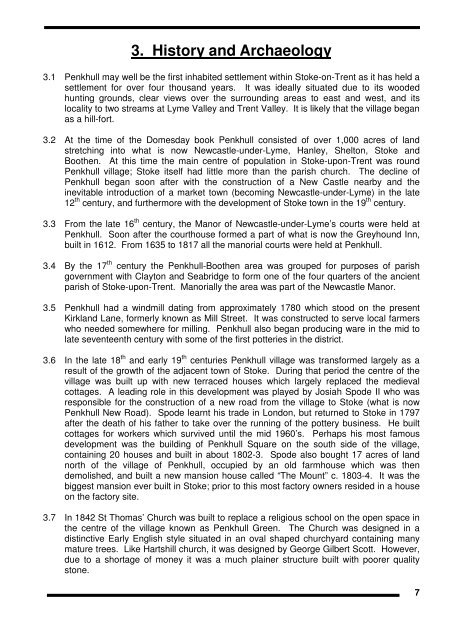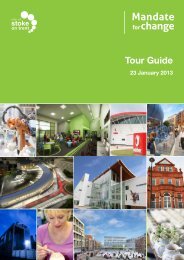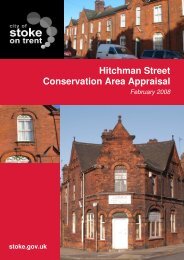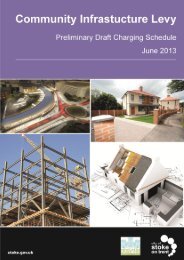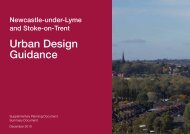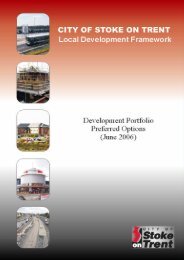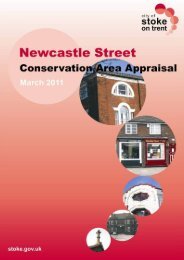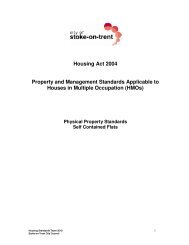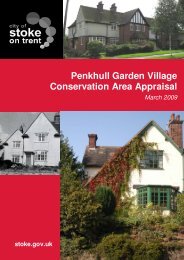Penkhull Village Conservation Area Appraisal - Stoke-on-Trent City ...
Penkhull Village Conservation Area Appraisal - Stoke-on-Trent City ...
Penkhull Village Conservation Area Appraisal - Stoke-on-Trent City ...
- No tags were found...
Create successful ePaper yourself
Turn your PDF publications into a flip-book with our unique Google optimized e-Paper software.
3. History and Archaeology3.1 <str<strong>on</strong>g>Penkhull</str<strong>on</strong>g> may well be the first inhabited settlement within <str<strong>on</strong>g>Stoke</str<strong>on</strong>g>-<strong>on</strong>-<strong>Trent</strong> as it has held asettlement for over four thousand years. It was ideally situated due to its woodedhunting grounds, clear views over the surrounding areas to east and west, and itslocality to two streams at Lyme Valley and <strong>Trent</strong> Valley. It is likely that the village beganas a hill-fort.3.2 At the time of the Domesday book <str<strong>on</strong>g>Penkhull</str<strong>on</strong>g> c<strong>on</strong>sisted of over 1,000 acres of landstretching into what is now Newcastle-under-Lyme, Hanley, Shelt<strong>on</strong>, <str<strong>on</strong>g>Stoke</str<strong>on</strong>g> andBoothen. At this time the main centre of populati<strong>on</strong> in <str<strong>on</strong>g>Stoke</str<strong>on</strong>g>-up<strong>on</strong>-<strong>Trent</strong> was round<str<strong>on</strong>g>Penkhull</str<strong>on</strong>g> village; <str<strong>on</strong>g>Stoke</str<strong>on</strong>g> itself had little more than the parish church. The decline of<str<strong>on</strong>g>Penkhull</str<strong>on</strong>g> began so<strong>on</strong> after with the c<strong>on</strong>structi<strong>on</strong> of a New Castle nearby and theinevitable introducti<strong>on</strong> of a market town (becoming Newcastle-under-Lyme) in the late12 th century, and furthermore with the development of <str<strong>on</strong>g>Stoke</str<strong>on</strong>g> town in the 19 th century.3.3 From the late 16 th century, the Manor of Newcastle-under-Lyme’s courts were held at<str<strong>on</strong>g>Penkhull</str<strong>on</strong>g>. So<strong>on</strong> after the courthouse formed a part of what is now the Greyhound Inn,built in 1612. From 1635 to 1817 all the manorial courts were held at <str<strong>on</strong>g>Penkhull</str<strong>on</strong>g>.3.4 By the 17 th century the <str<strong>on</strong>g>Penkhull</str<strong>on</strong>g>-Boothen area was grouped for purposes of parishgovernment with Clayt<strong>on</strong> and Seabridge to form <strong>on</strong>e of the four quarters of the ancientparish of <str<strong>on</strong>g>Stoke</str<strong>on</strong>g>-up<strong>on</strong>-<strong>Trent</strong>. Manorially the area was part of the Newcastle Manor.3.5 <str<strong>on</strong>g>Penkhull</str<strong>on</strong>g> had a windmill dating from approximately 1780 which stood <strong>on</strong> the presentKirkland Lane, formerly known as Mill Street. It was c<strong>on</strong>structed to serve local farmerswho needed somewhere for milling. <str<strong>on</strong>g>Penkhull</str<strong>on</strong>g> also began producing ware in the mid tolate seventeenth century with some of the first potteries in the district.3.6 In the late 18 th and early 19 th centuries <str<strong>on</strong>g>Penkhull</str<strong>on</strong>g> village was transformed largely as aresult of the growth of the adjacent town of <str<strong>on</strong>g>Stoke</str<strong>on</strong>g>. During that period the centre of thevillage was built up with new terraced houses which largely replaced the medievalcottages. A leading role in this development was played by Josiah Spode II who wasresp<strong>on</strong>sible for the c<strong>on</strong>structi<strong>on</strong> of a new road from the village to <str<strong>on</strong>g>Stoke</str<strong>on</strong>g> (what is now<str<strong>on</strong>g>Penkhull</str<strong>on</strong>g> New Road). Spode learnt his trade in L<strong>on</strong>d<strong>on</strong>, but returned to <str<strong>on</strong>g>Stoke</str<strong>on</strong>g> in 1797after the death of his father to take over the running of the pottery business. He builtcottages for workers which survived until the mid 1960’s. Perhaps his most famousdevelopment was the building of <str<strong>on</strong>g>Penkhull</str<strong>on</strong>g> Square <strong>on</strong> the south side of the village,c<strong>on</strong>taining 20 houses and built in about 1802-3. Spode also bought 17 acres of landnorth of the village of <str<strong>on</strong>g>Penkhull</str<strong>on</strong>g>, occupied by an old farmhouse which was thendemolished, and built a new mansi<strong>on</strong> house called “The Mount” c. 1803-4. It was thebiggest mansi<strong>on</strong> ever built in <str<strong>on</strong>g>Stoke</str<strong>on</strong>g>; prior to this most factory owners resided in a house<strong>on</strong> the factory site.3.7 In 1842 St Thomas’ Church was built to replace a religious school <strong>on</strong> the open space inthe centre of the village known as <str<strong>on</strong>g>Penkhull</str<strong>on</strong>g> Green. The Church was designed in adistinctive Early English style situated in an oval shaped churchyard c<strong>on</strong>taining manymature trees. Like Hartshill church, it was designed by George Gilbert Scott. However,due to a shortage of m<strong>on</strong>ey it was a much plainer structure built with poorer qualityst<strong>on</strong>e.7


